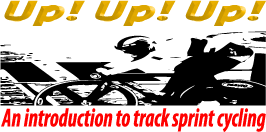Equipment
If you go and watch a road race or a track endurance event, even at elite level, you'll see a lot of variation in equipment. This is because, on the whole, roadies and track enduro riders (except pursuiters) don't care about fractions of a second and they ride whatever's most sexy. Their races aren't determined by tenths of a second or less and they don't, in normal use, put much stress on their equipment.
Qualifying for the sprint means you need to ride a very quick flying 200, often less than three tenths of a second separate the top eight or sixteen riders. Every second may count to Lance Armstrong, but to track sprinters, hundredths of a second count, and that means our equipment matters. Standing starts put huge amounts of torque through our bottom brackets and chains, cornering under power at greater than 70km/h around banked tracks puts huge stresses on our wheels and bike frames. This is why at World Cup level there'll be a small number of frames on display and often only one maker of wheels. The Mavic iO and Comete wheelset was the most common at elite level at the time this book went to press and manufacturers such as BT, Look, Koga and Dolan are some of the few that make bikes suitable for elite level track sprint competition.
However, when you start out, your bicycle is unlikely to be a limiting factor in your performance. It needs to be strong more than light weight and you will need wheels strong enough to survive abuse on a velodrome, which means crashes, big gear standing start efforts and high cornering loads. You will want to have sprint handlebars. These must be very strong and be curved such that you don't bash your forearms against them when doing a standing start. Chances are when you buy a track bike that it does not come with sprint bars. You will need to change this quickly!
Do you need or want aerobars? If you're riding kilos or 750 metre time trials then yes you certainly do. If you're riding 500m time trials the answer is not so clear. At the time of writing (December 2010) the world record for the 500 is held by Simona Krupeckaite from Lithuania, who did not use aero bars. The previous world record holder, Anna Meares from Australia, did. So for the 500 it's not necessarily a requirement to use aerobars.
You will want pedals with toe straps and cleats. Commonly sprint cyclists use Shimano SPD-SL pedals and attach toe straps with cable (or zip) ties, even at elite national level. Look Keo pedals are also common again with cable ties attaching toe straps although an adapter is available to make a hard metal mount for the strap.
Beginner track sprint cyclists in Australia often start out on a basic track bike with 32 hole basic wheels and sprint handlebars. Affordable track bikes such as the Hillbrick Pista are solid and robust and more than one junior state championship has been won on basic bikes like this.
You're going to want access to a velodrome and a starting gate and hopefully also a motorcycle for motorpaced training efforts and a heavy duty ergo trainer and a road bike. Many velodrome owners will have start gates and often have a motorcycle that you can hire. We recommend a basic road bike and an ergo such as the Kurt Kinetic Road Machine or the BT Ergo, one that provides a fluid resistance and a significant flywheel is going to be much more useful than a basic magnetic resistance trainer that roadies use for endurance training.
